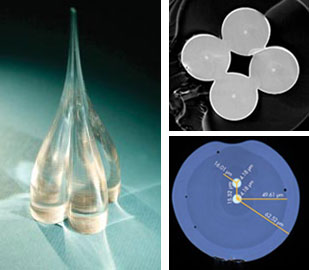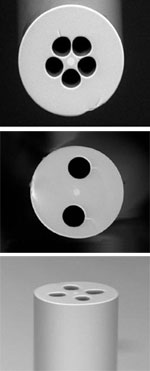Dr. Saeed Rehman, Fibertronix AB, and Dr. Åsa Claesson, Acreo Fiberlab
Optical fiber is well-known for its ability to carry information at high speeds over long distances. Twenty years after the first transatlantic fiber optic cable was laid, these strands of ultrapure glass continue to offer unrivaled bandwidths. They have evolved a long way from the first low-loss fiber demonstrated in the late 1960s.
Less often thought of are a multitude of other applications. Fiber optic technologies offer unique features that can be exploited in a variety of ways, such as carrying high optical powers in flexible lightguides for welding stations, transferring images in endoscopes, distributed sensing along pipelines, and for low-weight and high-transmission bandwidth in avionics.
One of today’s fastest developing technologies is fiber optic sensing. Over the past few years, fiber sensors have seen increased acceptance and widespread use in many commercial applications, including structural sensing; smart structures and civil engineering; aerospace and security; the marine, oil and gas fields; and health monitoring. One of the most common functions is temperature and strain/stress sensing, but a range of other parameters – such as pressure, magnetic field, voltage, chemical species and others – also can be measured.
The significant advantages that these sensors have over more conventional ones for distributed sensing and structural health monitoring have long been understood. However, only in recent years has this technology sufficiently matured to find real field applications and to see steady growth in both standard and niche applications. The expansion of fiber optic sensors continues, and their impact on several business sectors will be significant. This article explains the significance of specialty fibers for growing the next generation of fiber sensors.
Specialty fiber for sensing
The term “specialty fiber” is used for practically any fiber except the highest-volume communications type. The specialty fiber market is growing steadily, with industrial, security and military markets making the most impact. Some types of specialty fibers have well-established volume markets; others are still used exclusively in research and development. A substantial portion of the business comes from military/aerospace applications, such as fiber optic gyroscopes, fiber-guided missiles and submarine hydrophones, as well as from oil and gas applications.
Major specialty fiber types include polarization-maintaining fibers (with applications in fiber gyroscopes, current sensors, lasers and pigtailing), polyimide-coated fibers (harsh environments), erbium- and ytterbium-doped fibers (lasers and amplifiers), photosensitive fibers, and multimode fibers for transport of high-power laser light.
In fiber sensors, a specialty fiber is often a key component, acting either as a transducer or an information carrier, and sometimes serving as both. With special coatings such as polyimides, silicones, high-temperature acrylates or hermetic coatings, the specialty fiber may be adapted to a harsh environment. In the final design, additional structures, such as buffer layers or cable designs, along with supplemental strength elements, are frequently needed.
Some fibers are considered more or less industry standard in fiber sensing. They include single- and multimode polyimide-coated fibers for high-temperature applications, pure silica core (“pure core”) fibers, and hermetic fibers for hydrogen-rich and radiation-resistant applications.
Gemini fibers enable practical multicore applications
Besides these “standard” specialty fibers, some new types have been created, thanks to advances in fabrication technology, addressing some unique and complicated sensing solutions. We will give some recent examples of advanced fibers for sensing and explain their potential uses.
Multicore fibers have several sensing applications besides endoscopy. With the information extracted from the light in various cores, a range of physical parameters can be monitored. With the cores integrated into the same fiber, they will experience the same temperature, and it is possible to eliminate the temperature dependence of such sensors by working with the difference between signals from neighboring cores. Such multicore fibers with integrated fiber Bragg grating (FBG) sensors can be employed for temperature-independent bend sensing. The sensor employs two FBGs, one in each core of a two-core fiber. On bending, the two FBGs will experience a strain and a compression, respectively, but they will both see the same temperature shift. The difference in wavelength will provide the strain, independent of the temperature reading.
An obstacle with multicore fibers that restricts their use in practical applications is the input and output from individual cores. Until recently, there was no simple, robust, low-loss and cost-effective way of contacting the individual cores. The Gemini fiber overcomes these coupling difficulties by allowing standard equipment to create all-fused, robust and low-loss contacting of multicore sensors.
In a Gemini fiber, several single fibers are drawn together into a multifiber assembly, as shown in Figure 1. The fibers are independent of each other, except for a narrow connecting glass bridge, and the original individual circular cross sections are maintained. The fibers have a Siamese character and are in proximity to one other. Addressing the individual cores at the input and output ends is possible, through splicing to stand-alone fibers. Although thermal coupling is weaker than in a conventional multicore fiber, the easier access to the cores is greatly advantageous, and the structure is a good compromise for various sensing applications.

Figure 1. The Gemini fiber integrates ease of splicing and contacting with the concept of multicore fiber sensing. Photos courtesy of Acreo AB.
Gemini fibers with two and four cores have shown excellent bend-sensing results. The possibility of drawing Gemini fibers with different types of cores, as well as fabricating fused couplers directly using the Gemini fiber, opens a variety of sensor concepts. For example, a Gemini fiber has also been used for constructing an interferometer, with the Gemini structure providing equal arm lengths and a wide-band passband.
Using the Gemini concept, one can devise a sensor that monitors the location of medical probes inside the body during minimally invasive surgery. Such a system could be constructed with an FBG array in a Gemini fiber, which would sense the position of the probe in the body, its path and the various bends. This system could open up cost-efficient and simplified minimally invasive surgical procedures.
As new applications are found, the complexities of the fiber sensors are increasing. For example, in structural health monitoring, it is imperative to detect the stress not only along the length of the sensing fiber but also in transverse directions to map three-dimensional dynamical stresses. When the fiber is put under an asymmetric stress, the birefringence will be changed. One can then detect the difference in transverse stress in two dimensions, for instance by spectrally distinguishing two reflection peaks associated with orthogonal polarizations. With asymmetric holes in the cross section of microstructured fibers, as in Figure 2, the birefringence response is enhanced and can be detected more easily.

Figure 2. These fibers have holes for sensors, lasers and components.
In many fiber sensors, properties of the lightguide itself change, depending upon the measurand. It can be an FBG that changes reflection wavelength on temperature or stress, or an electro-optic fiber that changes its refractive index on an external electric field. In other sensors, the measurand changes the properties of external stress elements (causing loss by microbends in the fiber).
Yet other types of sensors employ special coatings or claddings, adapted to change their physical parameters, depending on the measurand. Examples are coatings that change their optical properties on pH or chemical substances, and coatings that change parameters on external pressure. Microstructural fibers can also be used for chemical detection if the holes are filled with different chemical-sensitive materials. Techniques are being developed to allow for low-loss coupling of liquids and light into fibers with holes, as well as for optical probing of electrophoresis in the holes.
Recently, nanowires have also stirred the scientific sensor community, promising extreme-interaction cross sections of light with liquids and gases. The nanowires are fabricated by tapering fibers into minute wires, so the lightguiding is no longer restricted to the glass but rather extends outside the physical fiber. The evanescent field can then be used for sensing gases, bacteria or other interesting measurands.
With the introduction of new specialty fibers, it is possible to address some old, complicated industrial problems. By defining the problems and using their imagination, end users can find a suitable solution using this ever-growing range of specialty fibers.
Meet the authors
Saeed Rehman is vice president of business development at Fibertronix AB, Hudiksvall, Sweden; e-mail: [email protected]. Åsa Claesson is manager of fiber photonics at Acreo Fiberlab, Hudiksvall, Sweden.